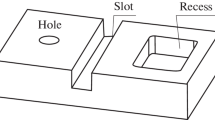Abstract
Tool wear regulation highly influences product quality and the safety and productivity of machining processes. Hence, it is one of the most important elements in the supervisory control of machine tools. The development of this type of machine tool adaptive control is practically at its infancy because there are still no industrial solutions concerning robust, reliable, and highly precise continuous tool wear estimators. Therefore, this paper primarily aims at the determination of a tool wear regulation model that can ensure the maximum allowed amount of tool wear rate within a predefined machining time, while simultaneously maintaining a high level of process productivity. The proposed model is structured using Radial Basis Function Neural Network controller and Modified Dynamical Neural Network filter. It is analysed using an analytical tool wear model with experimentally adjusted parameters.
Similar content being viewed by others
References
S. Liang, R. L. Hecker and R. G. Landers, Machining Process Monitoring and Control: The State-of-the-Art, ASME Journal of Manufacturing Science and Engineering, 126 (2004) 297–310.
Y. Koren, Computer Control of Manufacturing Systems, Mc Grow-Hill Inc., New York, USA, (1983).
R. G. Landers, A. G. Ulsoy and R. J. Furness, Process Monitoring and Control of Machining Operations, Mechanical Systems Design Handbook, CRC Press, USA, (2002).
J. C. Filho and A. E. Diniz, Influence of Cutting Conditions on Tool Life, Tool Wear and Surface Finish in the Face Milling Process, Journal of the Brazilian Society of Mechanical Sciences, 24(1) (2002) 10–14.
E. Kilickap, O. Cakir, M. Aksoy and A. Inan, Study of tool wear and surface roughness in machining of homogenised SiC-p reinforced aluminium metal matrix composite, Journal of Materials Processing Technology, 164–165 (2005) 862–867.
Y. Koren and E. Lenz, Mathematical model for the Flank Wear while Turning Steel with Carbide Tools, CIRP Proceedings on Manufacturing Systems, (1972) 127–139.
K. Danai and A. G. Ulsoy, A Dynamic State Model for On-Line Tool Wear Estimation in Turning, ASME Journal of Engineering for Industry, 109(4) (1987) 396–399.
A. G. Ulsoy, Y. Koren, T. R. Ko and J. Park, Model-Based Tool Wear Estimation in Metal Cutting, Proceedings of 15th Conference on Production Research and Technology, University of California, Berkeley, USA, (1989) 237–239.
J.-J. Park and A. G. Ulsoy, On-Line flank wear estimation using an adaptive observer and computer vision — Part 1: Theory, ASME Journal of Engineering for Industry, 115 (1993) 30–36.
M. Ayoubi, M. Schefer and S. Sinsel, Dynamic neural units for nonlinear dynamic systems identification, Lecture Notes in Computer Science, 930 (1995) 1045–1051.
M. Riedmiller and H. Braun, A Direct Adaptive Method for Faster Backpropagation Learning: The RPROP Algorithm, Proceedings of the IEEE International Conference on Neural Networks (ICNN), San Francisco, USA, (1993) 586–591.
M. Riedmiller, Advanced Supervised learning in Multi-layer Perceptrons — From Backpropagation to Adaptive Learning Algorithms, International Journal of Computer Standards and Interfaces, Special Issue on Neural Networks, 16 (1994) 265–278.
C. Igel and M. Husken, Improving the RPROP Learning Algorithm, Proceedings of the Second International Symposium on Neural Computation, Berlin, Germany, (2000) 115–121.
J. Leski and E. Czogala, A new artificial neural network based fuzzy inference system with moving consequents in if-then rules and selected applications, Fuzzy Sets and Systems, 108 (1999) 289–297.
D. S. Mitrinovic, J. E. Pecaric and A. E. Fink, Classical and New Inequalities in Analysis, Kluwer Academic Publishers, Netherland, (1993).
Author information
Authors and Affiliations
Corresponding author
Additional information
This paper was recommended for publication in revised form by Associate Editor In-Ha Sung
Danko Brezak received his B.Sc., M.Sc. and Ph.D. in Mechanical Engineering from the Faculty of Mechanical Engineering and Naval Architecture, University of Zagreb, Croatia in 1998, 2003 and 2007, respectively. He is currently a senior research assistant in the Department of Robotics and Production Systems Automation at the Faculty of Mechanical Engineering and Naval Architecture, University of Zagreb. His research interests include neural networks, fuzzy logic systems, machining process monitoring and control algorithms.
Dubravko Majetic received his B.Sc., M.Sc. and Ph.D. in Mechanical Engineering from the University of Zagreb, Croatia, in 1988, 1992 and 1996, respectively. He is currently a professor in the Department of Robotics and Production Systems Automation at the Faculty of Mechanical Engineering and Naval Architecture, University of Zagreb. His research is oriented towards automatic control and artificial intelligence.
Toma Udiljak finished Mechanical Engineering at the University of Zagreb, Croatia, where he also received his M.Sc. in 1988 and Ph.D. in 1996. He became a professor in 2004. He is currently serving as head of the Machine Tools Chair. His research is oriented towards cutting theory, CAM, and autonomous manufacturing systems.
Josip Kasac received his B.Sc. in Physics from the University of Zagreb in 1995. He then received his M.S. and Ph.D. in Mechanical Engineering from the University of Zagreb in 1998 and 2005, respectively. He is currently an Assistant Professor in the Department of Robotics and Production Systems Automation at the Faculty of Mechanical Engineering and Naval Architecture, University of Zagreb, Croatia. His research interests include robot control, optimal control, neural network, and fuzzy control.
Rights and permissions
About this article
Cite this article
Brezak, D., Majetic, D., Udiljak, T. et al. Flank wear regulation using artificial neural networks. J Mech Sci Technol 24, 1041–1052 (2010). https://doi.org/10.1007/s12206-010-0308-5
Received:
Revised:
Accepted:
Published:
Issue Date:
DOI: https://doi.org/10.1007/s12206-010-0308-5




